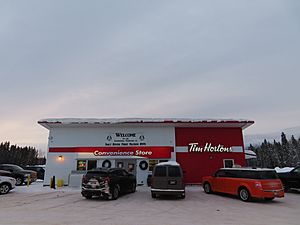Urban Indian reserve facts for kids
An urban Indian reserve (French: réserve indienne urbaine) is a special piece of land in a city or town in Canada. The Government of Canada sets aside these lands as First Nations reserves. They are different from regular reserves because they are right inside or very close to a city.
These urban reserves help First Nations communities by letting them run businesses. These businesses often have tax benefits, just like businesses on traditional reserves. This helps the First Nations earn money. Sometimes, a city grows and surrounds an existing reserve, making it an urban reserve. Other times, new land in a city is chosen to become an urban reserve.
Some urban reserves are like smaller business hubs connected to larger reserves outside the city. The money made from these city businesses can help support the people and services in the main, rural reserve.
Contents
History of Urban Reserves in Canada

The idea of urban reserves started to grow in the 1980s. The very first one was set up in 1981 in Kylemore, Saskatchewan. It was managed by the Fishing Lake First Nation, which is part of Treaty 4. Soon after, in 1982, another urban reserve was created in Prince Albert, Saskatchewan by the Peter Ballantyne Cree Nation (Treaty 6).
A big step happened in 1988 when the Muskeg Lake Cree Nation created a large urban reserve in Saskatoon. This reserve, which was about 33 acres, was meant for businesses. By 2004, it had grown a lot. It had 37 businesses and provided jobs for 350 people. Today, it's known as the McKnight Commercial Centre.
In 1992, an important agreement called the Treaty Land Entitlement Framework Agreement (TLEFA) was signed. This agreement helped settle land claims for 28 First Nations groups in Saskatchewan. It also made it easier for First Nations to work with city governments to create new urban reserves.
Urban reserves are not just in Saskatchewan. At least four have been set up in Manitoba. One of these, near Winnipeg, belongs to the Roseau River Anishinabe First Nation (Treaty 1). It has a gas station and a tobacco store, with plans to add a medical center and even car dealerships.
Why Urban Reserves Matter
Urban reserves are a topic of discussion. Some people, like the Canadian Taxpayers Federation, worry that businesses on urban reserves get tax breaks that other city businesses don't. They also point out that it can be complicated to sell or change urban reserve lands, as it needs approval from the First Nation and the land would go back to the federal government. Other groups, like the Frontier Centre for Public Policy, agree that urban reserves have benefits but believe the whole reserve system should be changed.
However, many people support urban reserves. They say these reserves create new business chances for First Nations people. They also believe that the surrounding cities benefit too. When businesses on urban reserves do well, they can create more jobs and economic activity for everyone in the area. This helps both First Nations communities and their city neighbors.
Examples of Urban Reserves
Here are some examples of urban reserves in Canada:
- Capilano Indian Reserve No.5 in Vancouver, British Columbia
- Enoch Cree Nation 135, which is next to Edmonton, Alberta
- Kitsilano Indian Reserve No.6 in Vancouver, British Columbia
- Mission Indian Reserve No.6, which is next to North Vancouver, British Columbia
- Tsuu T'ina Nation 145, Alberta, which is next to Calgary, Alberta
- Membertou First Nation in Sydney, Nova Scotia
- Cole Harbour 30 in Cole Harbour, Nova Scotia
- St. Mary's First Nation in Fredericton, New Brunswick
- Long Plain 6B, Manitoba, which is next to Portage la Prairie, Manitoba
- Long Plain 6C, Manitoba in Winnipeg, Manitoba
- Wendake, a First Nation community surrounded by Quebec City, Quebec
- Kahnawake, Quebec, which is next to Montreal, Quebec
See also
- Urban Māori
- Urban Indian

